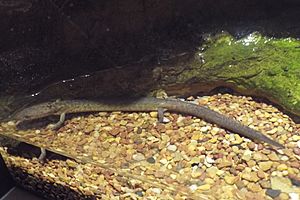Tennessee cave salamander facts for kids
Quick facts for kids Tennessee cave salamander |
|
|---|---|
 |
|
| Specimen at the Tennessee Aquarium | |
| Conservation status | |
| Scientific classification | |
|
The Tennessee cave salamander (Gyrinophilus palleucus) is a special type of salamander. It belongs to the family called Plethodontidae, which means it breathes through its skin, not lungs! This salamander is found only in the Appalachian Mountains in the United States. It lives in streams deep inside caves. Sadly, its home is in danger, which means the salamander is also at risk.
Where it Lives
The Tennessee cave salamander makes its home in the southern part of the Cumberland Plateau. This area is part of the big Appalachian Mountains in the United States. You can find this salamander in south-central Tennessee, western North Carolina, northeastern Alabama, and northwestern Georgia. It lives in cave systems, and scientists think it might even be in some caves that people haven't explored yet!
Life in the Caves
What it Eats
This salamander eats small water creatures that live in caves. Its diet includes tiny shrimp-like animals called amphipods and other small bugs that live in the water.
Its Home
The Tennessee cave salamander lives on sand, gravel, mud, or rocks. It likes streams and pools inside caves. It prefers clear water that doesn't have a lot of dirt or mud in it. Sometimes, people see these salamanders outside of caves. This usually happens when heavy rain washes them out by accident.
Life Cycle
Most of the time, these salamanders stay in their young, larval form for their entire lives. This is called being paedomorphic. It means they keep their larval look, like having gills, even when they are old enough to have babies. But sometimes, a few of them will grow up and change into their adult form, just like other amphibians.
Why it Needs Our Help
The Tennessee cave salamander lives in caves and needs good, clean water in the streams there. It faces many dangers. These include water pollution, too much dirt in the water (called siltation), and floods. People also sometimes fill in sinkholes or dump trash, which harms the salamander's home.
This salamander is found in about two dozen cave systems. Its total living area is smaller than 2,000 square kilometers (about 770 square miles). The number of these salamanders in one cave in Tennessee seems to be going down. Because of these reasons, the International Union for the Conservation of Nature says this salamander is "threatened". They suggest protecting the areas where water flows into the caves where these salamanders live.


